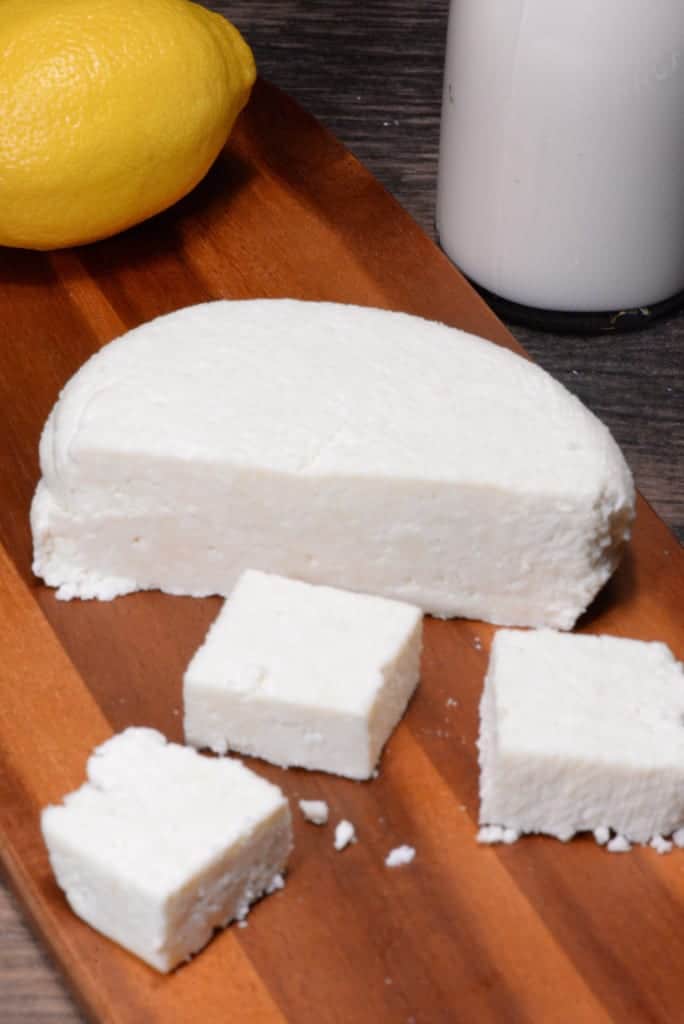INDIAN PANEER (CHEESE)
Indian Paneer (cheese) is made with only two ingredients. This cheese is used in many Indian recipes and is wonderful on the grill as well. It literally only takes about 45 minutes to make and it is ready to be added your palak, an amazing spinach curry or any other Indian dish.
It is a dense cheese that reminded me a bit of tofu, on it’s own it doesn’t have much flavor but when added to any type of flavoring or curry, boy oh boy does it soak it up. YUM!

PREP TIME
25 mins
COOK TIME
15 mins
TOTAL TIME
40 mins
Recipe type: Cheese
Cuisine: Indian
Serves: 12 ozs
It is a dense cheese that reminded me a bit of tofu, on it’s own it doesn’t have much flavor but when added to any type of flavoring or curry, boy oh boy does it soak it up. YUM!

INDIAN PANEER (CHEESE)
PREP TIME
25 mins
COOK TIME
15 mins
TOTAL TIME
40 mins
Recipe type: Cheese
Cuisine: Indian
Serves: 12 ozs
INGREDIENTSCheesecloth
8 cups whole milk
¼ cup freshly squeezed lemon juice
INSTRUCTIONS
Line a large colander with a large double layer of cheesecloth, and set it in your sink.
In a large non stick pot, bring the milk to a slow gentle boil over medium heat, stirring frequently to avoid burning the bottom. This will take some time so Be patient!
Add the lemon juice and turn the heat down to low. Stirring gently, you should almost immediately see the curds (white milk solids) and whey (the greenish liquid) separate.
Remove the pot from the heat and pour the contents into the cheesecloth-lined colander. (You can save the whey for another purpose, by the way our chickens love the stuff! Gently rinse with cool water to get rid of the lemon flavor.
Grab the ends of the cheesecloth and twist the ball of cheese to squeeze out the excess whey. Tie the cheesecloth to your kitchen faucet and allow the cheese to drain for about 5 minutes.
Twist the ball to compact the cheese into a block, place it on a plate with the twisted part of the cheesecloth on the side and set another plate on top. Weigh the second plate down with something heavy like a can of beans or a heavy pot, or brick. Move to the refrigerator and let it sit about 20 minutes.
That's it, you can now unwrap your disc of homemade cheese! It is now ready to use in any number of Indian dishes, like Panak paneer.
8 cups whole milk
¼ cup freshly squeezed lemon juice
INSTRUCTIONS
Line a large colander with a large double layer of cheesecloth, and set it in your sink.
In a large non stick pot, bring the milk to a slow gentle boil over medium heat, stirring frequently to avoid burning the bottom. This will take some time so Be patient!
Add the lemon juice and turn the heat down to low. Stirring gently, you should almost immediately see the curds (white milk solids) and whey (the greenish liquid) separate.
Remove the pot from the heat and pour the contents into the cheesecloth-lined colander. (You can save the whey for another purpose, by the way our chickens love the stuff! Gently rinse with cool water to get rid of the lemon flavor.
Grab the ends of the cheesecloth and twist the ball of cheese to squeeze out the excess whey. Tie the cheesecloth to your kitchen faucet and allow the cheese to drain for about 5 minutes.
Twist the ball to compact the cheese into a block, place it on a plate with the twisted part of the cheesecloth on the side and set another plate on top. Weigh the second plate down with something heavy like a can of beans or a heavy pot, or brick. Move to the refrigerator and let it sit about 20 minutes.
That's it, you can now unwrap your disc of homemade cheese! It is now ready to use in any number of Indian dishes, like Panak paneer.
Source link from : https://www.internationalcuisine.com/category/recipes/side-dish/
BERITA LENGKAP DI HALAMAN BERIKUTNYA
Halaman Berikutnya